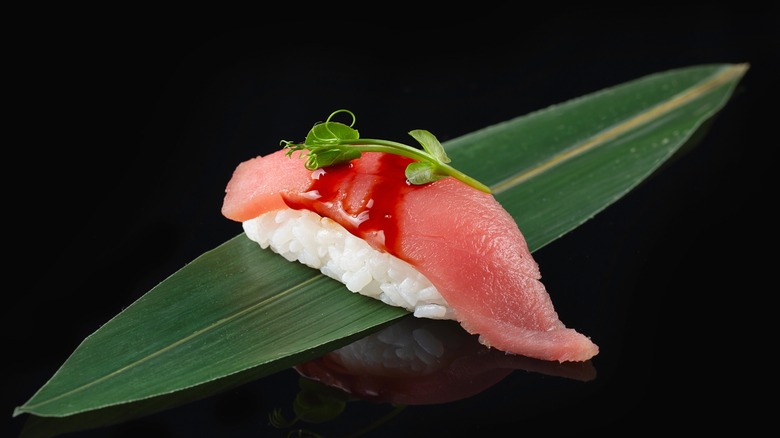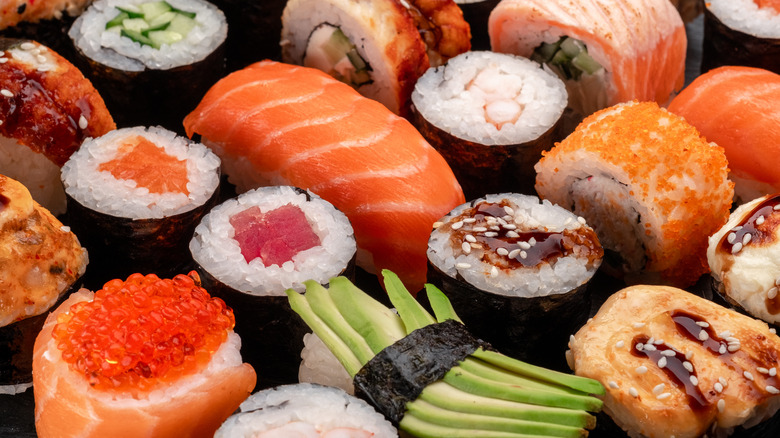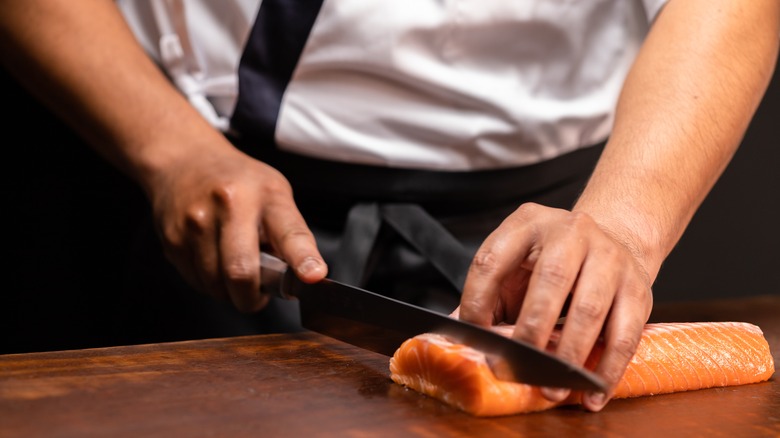The Sushi You Love Might Not Be What You Think It Is
Not long ago, most Americans had never even heard of sushi. The first sushi restaurant in the United States didn't open until the late 1960s (via Food52). How did this relatively recent culinary import become so trendy? It certainly helped that America's earliest sushi restaurants were opened in Los Angeles, earning attention through celebrity clientele, but even more important is that different types of sushi are considered healthier than many other fine dining options. People are willing to spend a great deal of money on sushi, purposefully avoiding bargains because consuming cheap fish is associated with various health issues. It's no surprise that Eater ranks Manhattan sushi bar Masa as America's most expensive restaurant. Unfortunately, those prices aren't always justified.
Food fraud is a rampant issue that many consumers are unaware of. The U.S. Food and Drug Administration classifies it as economically motivated adulteration (EMA). That's when a seller cheats their customers by mislabeling a product to make it seem more valuable. It's a problem in many industries, but especially with food. Examples of food fraud include diluting olive oil with vegetable oil, mixing corn syrup into pure maple syrup, and dying spices like turmeric to make them look more appealing. Disturbingly, seafood is commonly subject to food fraud, and the fish in your sushi might not be what you think it is. You could be wasting money or, worse, risking your health.
Most fish at sushi restaurants is mislabeled
You've probably heard about imitation crab used in sushi, but sellers may also pass off cheap fish as more expensive species. The conservation group Oceana conducted DNA testing on seafood samples from 674 American retailers and found that 33% of fish were mislabeled. The problem was even worse when they looked at sushi restaurants specifically. Out of 118 sushi bars surveyed, 95% sold mislabeled fish in one form or another. It's especially likely to happen when you order tuna or snapper. Just over 70% of sushi sold as tuna was actually a different fish, and a stunning 92% of sushi sold as snapper was illegitimate. It's a safer bet to order salmon, as only 18% of the salmon Oceana tested was fake.
Other studies show similar results. Inside Edition tested samples from sushi restaurants in New York and Los Angeles, finding that 68% were mislabeled. Another study by UCLA found that 47% of sushi at L.A. restaurants was mislabeled. In this case, most tuna was identified correctly, as was salmon, but halibut and snapper were almost always illegitimate. It's tempting to blame restaurant owners here, but Paul Barber, who authored UCLA's study, cautions against finger-pointing. He explains that mislabeling can happen at any point along the seafood supply chain, saying, "The amount of mislabeling is so high and consistent, one has to think that even the restaurants are being duped."
Here's what's really in your sushi
So, if you're not getting the fish you ask for, what are you getting? Let's start with the most innocuous example: salmon. The studies we've covered indicate that salmon is rarely swapped out for other fish, but Insider reveals that salmon labeled as wild often comes from a farm and would typically sell for less. Salmon labeled Pacific or Alaskan may actually be Atlantic, which is more common and frequently farmed. You should also be wary when you see the term "sushi grade" on a menu or at a fishmonger. Cook's Magazine explains that there are no regulations to guide the use of sushi grade and that it's a marketing tool used to make fish sound better in quality.
Now let's address some more egregious examples of seafood fraud. As previously mentioned, the DNA tests done by Oceana indicated that 92% of snapper is mislabeled. According to Insider, you're more likely to get tilapia or rockfish when you order snapper. Some sushi restaurants avoid snapper altogether, fearing that suppliers might dupe them. Perhaps the most concerning example of seafood fraud is white tuna. When you order white tuna, there's a good chance that you're really getting a fish called escolar, which can cause gastrointestinal problems. Perhaps it's wisest to stick with salmon, or better yet, bluefin tuna, the only fish that UCLA found was correctly labeled every time.


